Types of ventilation pipes: a detailed comparative overview of ventilation pipes
Ventilation planning is an important construction phase. The microclimate and the durability of the building depend on the efficiency of the ventilation system. Particularly responsible should be the choice of ducts. It should be understood what types of ventilation pipes are suitable for existing working conditions.
To deal with the issue, it is necessary to evaluate the properties of the materials from which they are made, as well as the features of the operation of products of different shapes and degrees of flexibility. This is what will be discussed in our article, where we will analyze in detail the characteristics of pipes made of various materials, providing the material with thematic photos.
The content of the article:
Ventilation duct requirements
Design and ventilation calculation - responsible work, requiring the contractor to have knowledge of building codes and an understanding of the principles of air exchange processes. Equally important are the parameters of the building itself and the climatic features of the region.
Regardless of the flow pattern (natural or forced stimulation), a network of ventilation ducts is set up.

Ducts must meet a number of requirements:
- Tightness. This property is necessary to maintain traction, as well as to prevent mixing of oncoming clean and exhaust air flows. Particular attention is paid to the connection of individual elements of the ventilation duct.
- Silent operation. The level of the aerodynamic drone should be within the sanitary standards. Permissible system noise is 25-35 dB.
- Corrosion resistance. Through the home pipeline, air masses of varying degrees of humidity are released. Water vapor is able to accumulate on the walls of ventilation ducts, causing the formation of rust.
- Compact and light weight. The total footage of the highways of the ventilation system is large enough not to overload the building and not clutter up the space; pipes with a minimum size that ensure unhindered circulation are selected.
- Fire safety. The material of the pipe fittings should not easily ignite and emit harmful fumes during combustion.
In addition to the main characteristics, the compliance of ventilation pipes with additional parameters is welcome: ease of installation, good thermal insulation properties and smoothness of the channels.

Types of materials and their operational properties
Most household ventilation pipes are made of metal or plastic. The product range has dozens of different positions. Alternative options for arranging the ventilation system include products from technical textiles and a sandwich pipe.
View # 1 - ducts made of plastic
The category of plastic pipes for ventilation has significantly supplanted traditional galvanizing and is increasingly used in creating duct networks for private households.
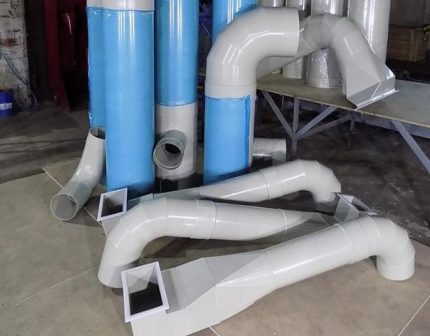
The main arguments for ventilation from polymer pipes:
- absolute non-susceptibility to corrosion, which can not be said about galvanized brothers;
- ease of installation and processing - plastic can be cut with a hacksaw, and to join individual elements by heating the ends, ensuring complete air tightness of the duct;
- light weight - in this matter polymers are beyond competition;
- surface smoothness and the absence of welds - resistance to moving air flow is reduced, which allows the use of fans of lower power;
- low cost.
Processing a plastic pipe with an antistatic agent minimizes dust “sticking” and reduces the number of cleanings. Due to the physical properties of the material, the pipeline practically does not “buzz”. Dimensions: length - 3-12 m, diameter - 16-1600 mm.
The listed advantages of plastic, along with low cost, make polymer products the most popular for ventilation. However, there are also negative aspects.
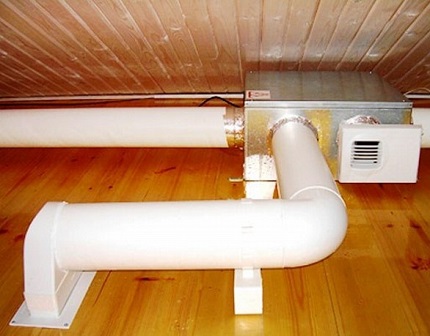
Giving preference to a plastic highway, it is necessary to take into account the features of a particular polymer.
The construction market offers the following types of ventilation pipes:
- Polyvinyl chloride. Advantages of PVC ducts: resistance to UV rays, availability, operating temperature range - from -10 ° C to +70 ° C. A popular area of application is exhaust pipes that provide ventilation in the kitchen and bathrooms.
- Polypropylene. The material surpasses PVC in technical and operational characteristics. Properties: boundary heating temperature +85 ° C, resistance to aggressive substances. There is a refractory variety (PPS) with flame retardants. Polypropylene is coated with an antistatic agent that minimizes dust accumulation.
- Ftoroplast. Fluorine-containing polymers are characterized by heat resistance (from -60 ° C to +200 ° C), UV resistance, and alkali and acid immunity.
- Polyethylene. Withstands negative temperatures up to -50 ° C and heating up to +80 ° C. The material retains its primary qualities under the influence of ultraviolet radiation.
Polyurethane products have similar characteristics with PVC pipes. The difference between the latter is high heat resistance (up to +270 ° C).
We recommend that you familiarize yourself with the nuances choosing plastic pipes for arrangement of ventilation.
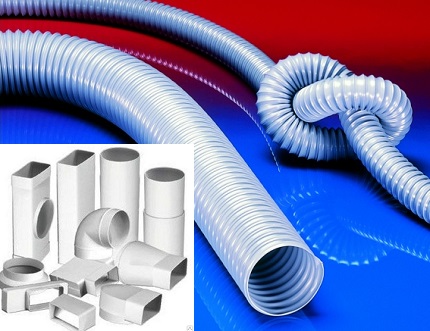
View # 2 - Galvanized Products
Galvanized pipe products are distinguished by their versatility - air ducts are used to equip industrial, administrative buildings and housing premises.
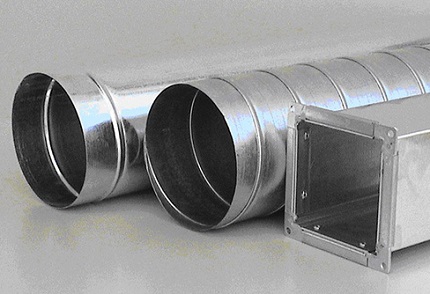
Permissible working environment of galvanized ventilation pipes: air temperature - up to +80 ° C, humidity - up to 60%. Galvanization meets all the requirements for air exchange systems. Restrictions in use - transportation of aggressive gas mixtures.
The benefits of galvanized steel:
- The light weight explains the ease of assembly of the ventilation system - there is no need to erect a complex supporting structure that increases the cost of the engineering network. An additional plus is the convenience of transporting pipe fittings.
- Mechanical strength - galvanized steel withstands point pressure, mechanical impact with sharp objects and point loads. Resistance to bending pressure is higher in a pipeline with stiffeners.
- Thanks to zinc treatment, the duct is not subject to corrosion even in conditions of stable high humidity. Galvanized pipes are suitable for organizing venting out.
- Under the influence of high temperature, galvanization retains its original size and shape. The fire resistance of pipes for high-rise buildings is 90 minutes.
- The service life of a galvanized duct varies from 20 to 25 years.
Additional arguments for galvanized steel: affordable price, the ability to produce pipes and fittings of various configurations.
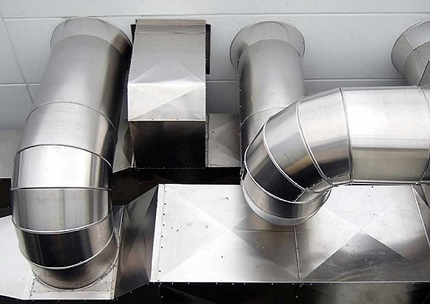
Based on the form and manufacturing principle, galvanized pipes for ventilation are divided into the following types:
- rectangular;
- round-seam;
- spiral-wound.
Rectangular products are produced on tunnel assembly machines. The standard length of the pipe cut is 1.25 m, the minimum section size is 10 * 10 cm. Rectangular ducts are equipped with stiffeners.
Round-seam rolling is characterized by a simple manufacturing technology. Galvanized sheet steel is cut, rolled into a pipe on rollers and fed to a folding machine for connecting the ends.
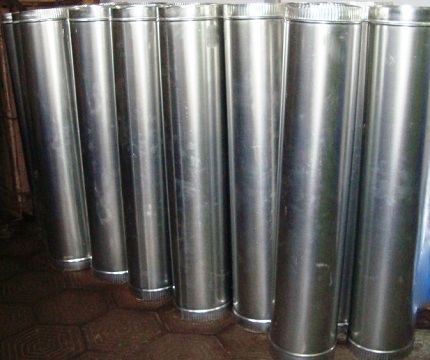
Spiral-wound products are made of galvanized strip (width - 137 mm), twisted into a spiral. Docking edges - lock connection with the outer seam.
The design of the pipes determines a number of positive qualities of the "spiral" ducts:
- significant rigidity;
- savings on the purchase of fittings;
- ease of installation;
- acceleration and low noise during air transportation - in the spiral channel, the turbulence of the flows increases.
Arrangement of a ventilation system with spiral-wound pipes will be cheaper than using rectangular products.
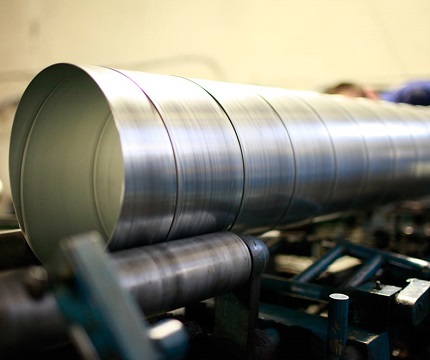
The wall thickness is normalized and depends on the diameter:
- 0.5 mm - for air ducts with a section up to 315 mm;
- 0.7 mm - products with a diameter of 350-800 mm;
- 0.9 mm - pipes with a standard size of 900-1250 mm;
- 1.2 mm - air ducts with a section of 1400-1600 mm.
According to the tightness class according to SNiP, galvanized pipes are divided into dense (P) and normal (N). The difference criterion is the method of making the weld.
In dense structures, the joining places after welding are rolled with a press and coated with sealant. Such an air duct can withstand pressure up to 1.5 MPa and is suitable for operation in buildings with increased explosion hazard. Normal ventilation products are installed in household systems.
View # 3 - stainless steel pipes
Stainless steel pipes have in their arsenal all of the listed advantages of rolled steel. The addition of chromium to the alloy makes the metal resistant to rust. Adjusting the composition by adding additional alloying elements gives the stainless steel specific qualities.
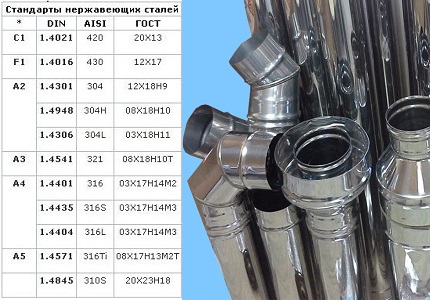
For the construction of ventilation systems, austenitic steel pipes are used, characterized by:
- corrosion resistance to many working environments;
- good manufacturability;
- strength and ductility;
- heat resistance - up to +500 ° C;
- chemical inertness to toxic and radioactive substances;
- durability.
Products made of chrome-nickel stainless steel are more expensive than galvanized ducts. Externally, the products are similar, which is sometimes used by unscrupulous manufacturers.
There are several ways to detect fake.
- Spectral analysis. Special instruments are required that determine the chemical composition of the metal.
- Visual inspection. On galvanizing, the presence of characteristic "stains" is permissible - crystallization patterns.
- Electromagnetic differences. Most stainless steel alloys are not magnetized, while a magnet is well attracted to steel.
- Chemical reaction. Zinc as a result of interaction with hydrochloric acid begins to bubble (hydrogen is released), and galvanization gradually disappears. For the experiment, one drop of acid is enough.
It should also be borne in mind that galvanized steel pipe rolling has a subtle bluish tint.
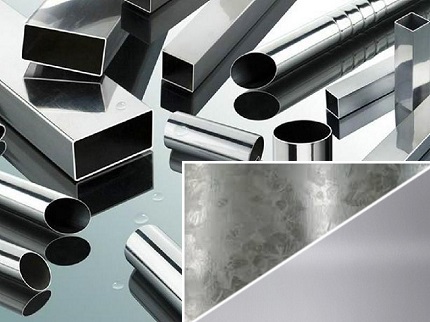
View # 4 - black steel products
Products from "black" hire are used in smoke removal, aspiration and ventilation systems. This is a good option for exhaust pipes with venting out. Regarding stainless steel and galvanizing, black steel has improved stiffness, fire resistance and heat resistance.
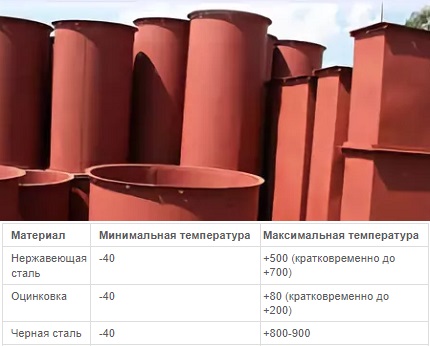
Characteristics of pipe fittings made of black steel:
- wall thickness - 1.2-1.5 mm;
- footage - 1.25-2.5 m.;
- pipe joining by flange method;
- execution options - rectangular, round section.
The cost of “black” rolled products is higher than for galvanized air ducts of a similar standard size, but lower compared to stainless steel.
View # 5 - sandwich pipe
Insulated air ducts are mounted when creating ventilation for fireplaces, stoves, and heating boilers. Pipes provide the proper level of fire safety of the system and the preservation of heat in the room.
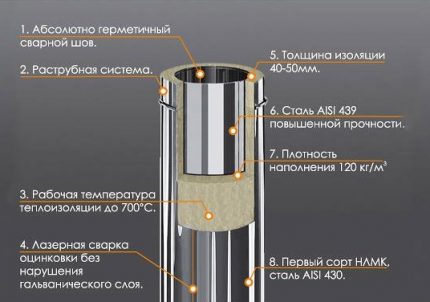
Basalt fiber is often used as a heat insulating filling.
Insulation characteristics:
- low thermal conductivity - up to 0.05 V * m / K;
- hydrophobicity - moisture absorption up to 2%;
- tensile strength - withstands pressure up to 10-60 kPa;
- biological resistance - the material does not rot, does not contribute to the propagation of fungi;
- fire safety - melting point about 1100 ° C;
- vapor permeability and sound insulation - partial "absorption" of vertical sound vibrations.
Basalt is chemically inert and does not react with metals - the risk of rust is reduced to zero. The choice of a sandwich pipe for exhaust ventilation depends on the operating conditions.
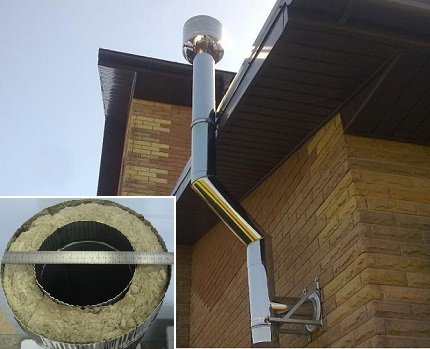
Advantages of the ventilation system from sandwich pipes:
- universality of application;
- ease of assembly;
- multi-layer pipeline prevents the formation of condensate;
- duct insulation
The disadvantages of insulated pipes include: high weight (2-2.5 times higher than metal, several times higher than polymers) and high cost.
View # 6 - technical textiles
Tissue air distribution system proposed by Danish developers 20 years ago. The novelty has partially replaced metal channels in the food, electronic, chemical industries, in catering, pools, concert and exhibition halls.
There are two types of textile pipes:
- airtight;
- breathable.
The purpose of airtight systems is the transportation and removal of air masses. The material of manufacture is polyamide.
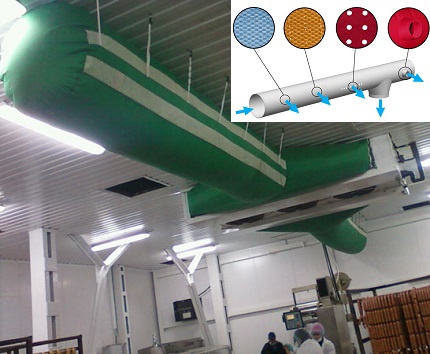
Tissue systems are free from the disadvantages of metal ducts. Significant advantages of textiles include:
- Lack of drafts. A draft is often observed in the air supply area from the metal / plastic channel. Through the textile pipes, “diffused” air jets are supplied.
- Noise-absorbing qualities. The fabric “dampens” the aerodynamic noise of the fan and airflows.
- Easy to clean. Textiles act as a barrier, partially filtering the supplied air. The material accumulates dust, but is easy to clean - it can be washed (50 cycles) and disinfected.
- Condensation protectionand. Due to vapor permeability, condensation does not form on the surface of the fabric pipe. Microorganisms do not develop in dry channels.
The optimum airflow rate for a textile pipe is 5-8 m / s, for other types of pipes also provided air flow rateto be considered when designing ventilation and choosing the material of the ducts.
With a decrease in pressure, the shape of the "sleeve" is retained due to thin sewn rings. Duct life is 10 years. Fire hazardous premises are equipped with textile pipes with additional fiberglass - boundary temperature +300 ° C.
Features of rigid and flexible ventilation ducts
The degree of flexibility distinguishes between rigid and flexible ducts. The choice between two positions depends on the complexity of the system being built and the operating conditions. When installing a rigid network, turns and transitions are formed using connecting corner elements.
We recommend that you familiarize yourself with the main types of fittings for steel pipes and the technology of various connection options.
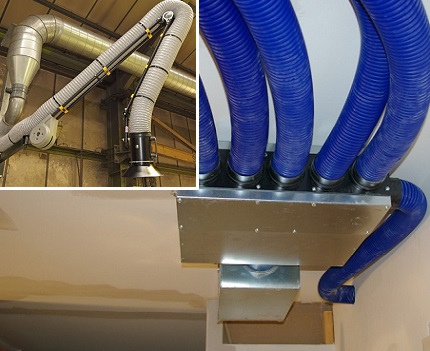
Flexible ducts are made of various materials. But, regardless of the material of manufacture, corrugated ductsCompared to hard channels, they have some disadvantages: low sound insulation, reduced air flow due to corrugated walls.
It is the composition of the pipe that determines its technical and operational properties:
- Aluminum corrugation: corrosion resistance, resistance to temperature fluctuations (-30 ° C / + 270 ° C), tightness, bending radius - 0.76 d, chemical inertness, fire resistance.
- Steel frame reinforced polyester. Characteristics: low cost, moisture resistance, low flammability, temperature range is -20 ° C / + 65 ° C, light weight. The disadvantage is the accumulation of static electricity.
- Polyester film with aluminum foil differs in high durability (admissible pressure - up to 2400 Pa), good aerodynamic properties.
- Thermal insulation corrugation reduces heat loss and prevents condensation.
Regardless of the type of ventilation pipe you choose, it is important to be able to install it correctly. Installation diagrams and detailed installation instructions for flexible and rigid ducts we reviewed here.
Comparison of circular and rectangular cross-section
Many people wonder what form of pipe to choose: round or rectangular? If you evaluate the throughput, round products win - air masses meet less resistance, which means that circulation is faster.
In rectangular pipes, the corners remain unused, so fittings with an increased cross-sectional area are selected. However, such a trunk takes up less space - wide and flat models are easier to hide behind a false ceiling or above cabinets.

Also, the cross section is an important parameter that is used when air duct area calculationnecessary to equip the ventilation system. Properly performed calculations will allow you to purchase the necessary amount of material without overpaying for extra pipes.
Conclusions and useful video on the topic
Characteristic features of plastic, asbestos-cement, corrugated aluminum and steel galvanized pipes for ventilation of the basement and the cellar:
The organization of a ventilation system requires a competent approach to the selection of the main structural elements - ventilation pipes. Most of the requirements for the air ducts of private houses are met by galvanized, stainless steel and plastic products.
Form - does not matter. Her choice depends on the characteristics of the trajectory of the ventilation network.
Choose the appropriate type of pipes for arranging the ventilation system, but have not found the answers to all your questions? Ask them in the comments under this article - our experts will try to help you.
Or do you have knowledge / practical experience in the installation of ventilation pipes and want to supplement our material with useful clarifications and comments? Write your opinion, add tips backed by practical experience.

 Sandwich pipe for ventilation: installation instructions and the nuances of assembling ventilation from a sandwich pipe
Sandwich pipe for ventilation: installation instructions and the nuances of assembling ventilation from a sandwich pipe  Water heater for fresh air: types, device, model overview
Water heater for fresh air: types, device, model overview  Nodes of passage of ventilation exhaust shafts: types, features of the choice, application and installation of penetration
Nodes of passage of ventilation exhaust shafts: types, features of the choice, application and installation of penetration 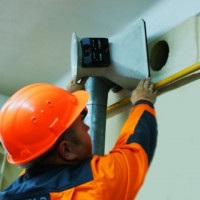 Ventilation cleaning: cleaning the ventilation ducts in an apartment building
Ventilation cleaning: cleaning the ventilation ducts in an apartment building  Supply and exhaust ventilation systems: a comparative overview of various types of equipment
Supply and exhaust ventilation systems: a comparative overview of various types of equipment 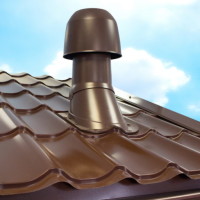 How to increase traction in ventilation: an overview of methods and devices for enhancing traction
How to increase traction in ventilation: an overview of methods and devices for enhancing traction  How much does it cost to connect gas to a private house: the price of organizing gas supply
How much does it cost to connect gas to a private house: the price of organizing gas supply  The best washing machines with dryer: model rating and customer tips
The best washing machines with dryer: model rating and customer tips  What is the color temperature of light and the nuances of choosing the temperature of the lamps to suit your needs
What is the color temperature of light and the nuances of choosing the temperature of the lamps to suit your needs  Replacement of a geyser in an apartment: replacement paperwork + basic norms and requirements
Replacement of a geyser in an apartment: replacement paperwork + basic norms and requirements